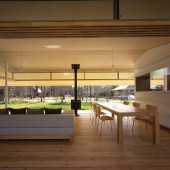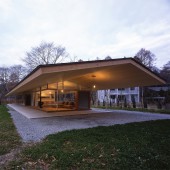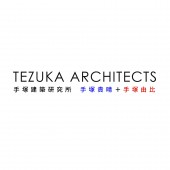The Pitched Roof House by Takaharu Tezuka and Yui Tezuka |
Home > Winners > #117210 |
 |
|
||||
| DESIGN DETAILS | |||||
| DESIGN NAME: The Pitched Roof PRIMARY FUNCTION: House INSPIRATION: Deep eaves, as one of the most important Japanese traditional architecture elements in local monsoon climate, are almost extinct in modern houses. It is essential to comprehend the meaning of these traditional elements in the modern setting. With the latest technology, the house seek to reinterpret the deep eave in the context of a humid climate, retain and create more opportunities for these distinctive Japanese qualities to sprout forth in modern architecture. UNIQUE PROPERTIES / PROJECT DESCRIPTION: This is a house located in Karuizawa, Japan with an extremely simple pitched roof. Traditional Japanese houses do not create enclosed environments but instead, form spaces that enable easy transition from the inside to the outside. By forming a blurred boundary, only forty percent of the space under the roof is enclosed within the interior. While the inside is being used primarily by the inhabitants as living spaces, it is the outside that defines it. OPERATION / FLOW / INTERACTION: The house is designed for a well-known Japanese pop songwriter who wanted to create a place where he could disconnect from the pressures of daily life. The space enclosed enables the inhabitants to perform their basic living tasks while open space under the deep eaves allows them to connect to nature and the surroundings. The sliding doors which divide the inside from the outside can be used to realize the shift in ambiance within the living space. PROJECT DURATION AND LOCATION: The project started in July 2007 and finished in May 2009 in Karuizawa, Japan FITS BEST INTO CATEGORY: Architecture, Building and Structure Design |
PRODUCTION / REALIZATION TECHNOLOGY: The cantilevered roof of over 6 meters, pushes the limit of the 200mm thick roof structure. By adopting a folded shape as the main structural element, it minimizes the support needed as compared to having a flat roof, which would require three times more of the support utilized. Like the Japanese papercraft, Origami, the L-shaped surface acts as a monocoque element – not resisting stiff but drooping about 5 centimeters under snow pressure like tree branches in the forest. SPECIFICATIONS / TECHNICAL PROPERTIES: Floor: Single floor Ceiling Height: 2,100 mm Roof Height: 3.446 mm Site Area: 1,059.18 m2 Floor Area: 208.56 m2 TAGS: House, Pitched Roof, Cantilevered, Japanese, Deep eaves, Boundary, Wood structure, RESEARCH ABSTRACT: The pitched roof house is trying to reach a certain level of mutability by re-interpreting the traditional elements into modern context. In aiming to heighten qualities of architectural mutability, the work is tied into a long tradition of Japanese vernacular architecture known for its sliding doors, screens, and other boundary-modulating elements, such as deep eaves. These elements not only create the spatial fluidity, but also open the architecture to life-giving elements of sunlight, wind, and humidity, modestly scaled the ubiquitous digital lifestyle with a return of nature. CHALLENGE: In Traditional Japanese Houses, the space under the eaves is often associated with columns. However, these columns serve purely as structural elements to support the cantilevered edges and are not crucial in enclosing the space. Had technology been much more advanced, we would have been able to design without columns years ago. We are now able to achieve the real intricate quality of open spaces in Japanese Architecture - a feat that was not possible for carpenters 400 years ago. ADDED DATE: 2021-02-02 02:15:23 TEAM MEMBERS (4) : Constructor: Niitsugumi Co., Ltd., Structure: OHNO-JAPAN, Lighting: BONBOLI Lighting Architect & Associates and Landscape: GA Yamazaki IMAGE CREDITS: Image #1: Photographer Katsuhisa Kida, FOTOTECA, 2009. Image #2: Photographer Katsuhisa Kida, FOTOTECA, 2009. Image #3: Photographer Katsuhisa Kida, FOTOTECA, 2009. Image #4: Photographer Katsuhisa Kida, FOTOTECA, 2009. Image #5: Photographer Katsuhisa Kida, FOTOTECA, 2009. |
||||
| Visit the following page to learn more: http://www.tezuka-arch.com/english/works |
|||||
| AWARD DETAILS | |
 |
The Pitched Roof House by Takaharu Tezuka and Yui Tezuka is Winner in Architecture, Building and Structure Design Category, 2020 - 2021.· Read the interview with designer Takaharu Tezuka and Yui Tezuka for design The Pitched Roof here.· Press Members: Login or Register to request an exclusive interview with Takaharu Tezuka and Yui Tezuka. · Click here to register inorder to view the profile and other works by Takaharu Tezuka and Yui Tezuka. |
| SOCIAL |
| + Add to Likes / Favorites | Send to My Email | Comment | Testimonials | View Press-Release | Press Kit |
Did you like Takaharu Tezuka and Yui Tezuka's Architecture Design?
You will most likely enjoy other award winning architecture design as well.
Click here to view more Award Winning Architecture Design.








